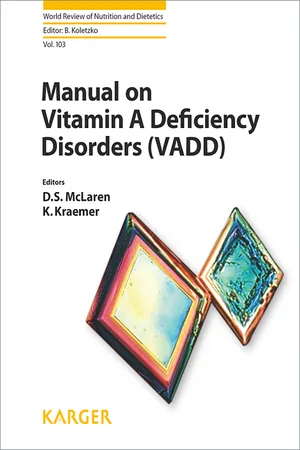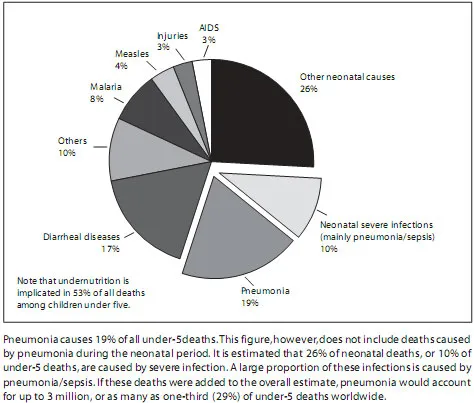
eBook - ePub
Manual on Vitamin A Deficiency Disorders (VADD)
- 204 pages
- English
- ePUB (mobile friendly)
- Available on iOS & Android
eBook - ePub
Manual on Vitamin A Deficiency Disorders (VADD)
About this book
Vitamin A plays a key role among the vitamins essential for healthy growth and development. Vitamin A deficiency disorders (VADD) are therefore an important part of general malnutrition that in the majority of cases leads to failure to thrive and underweight. Moreover, apart from adverse effects on health and survival in general, VADD can also lead to blindness, called xerophthalmia, and are also frequently accompanied by various infections. Last but not least, it has become evident that even mild degrees of VAD (and all other forms of nutritional deficiencies) have important adverse implications for health and are thus much more widespread than previously assumed. This publication systematically covers detailed and up-to-date information on every relevant aspect of VADD, with particular emphasis on providing an outline of their setting, nature, and significance. In addition to cutting-edge scientific information, the latest available data on the global occurrence of VAD from the World Health Organization is also included.
Frequently asked questions
Yes, you can cancel anytime from the Subscription tab in your account settings on the Perlego website. Your subscription will stay active until the end of your current billing period. Learn how to cancel your subscription.
No, books cannot be downloaded as external files, such as PDFs, for use outside of Perlego. However, you can download books within the Perlego app for offline reading on mobile or tablet. Learn more here.
Perlego offers two plans: Essential and Complete
- Essential is ideal for learners and professionals who enjoy exploring a wide range of subjects. Access the Essential Library with 800,000+ trusted titles and best-sellers across business, personal growth, and the humanities. Includes unlimited reading time and Standard Read Aloud voice.
- Complete: Perfect for advanced learners and researchers needing full, unrestricted access. Unlock 1.4M+ books across hundreds of subjects, including academic and specialized titles. The Complete Plan also includes advanced features like Premium Read Aloud and Research Assistant.
We are an online textbook subscription service, where you can get access to an entire online library for less than the price of a single book per month. With over 1 million books across 1000+ topics, we’ve got you covered! Learn more here.
Look out for the read-aloud symbol on your next book to see if you can listen to it. The read-aloud tool reads text aloud for you, highlighting the text as it is being read. You can pause it, speed it up and slow it down. Learn more here.
Yes! You can use the Perlego app on both iOS or Android devices to read anytime, anywhere — even offline. Perfect for commutes or when you’re on the go.
Please note we cannot support devices running on iOS 13 and Android 7 or earlier. Learn more about using the app.
Please note we cannot support devices running on iOS 13 and Android 7 or earlier. Learn more about using the app.
Yes, you can access Manual on Vitamin A Deficiency Disorders (VADD) by D. S. McLaren,K. Kraemer,D.S., McLaren,K., Kraemer, Berthold Koletzko,Berthold, Koletzko in PDF and/or ePUB format, as well as other popular books in Medicine & Infectious Diseases. We have over one million books available in our catalogue for you to explore.
Information
Chapter 1
McLaren DS, Kraemer K (eds): Manual on Vitamin A Deficiency Disorders (VADD).
World Rev Nutr Diet. Basel, Karger, 2012, vol 103, pp 1-6
World Rev Nutr Diet. Basel, Karger, 2012, vol 103, pp 1-6
______________________
Foreground
The story of how the complex of disorders of human health now known as Vitamin A Deficiency Disorders (VADD) came to be recognized over the course of time is a truly remarkable one. Detailed accounts have been published in recent years (McLaren 1999 and 2004a). Table 1.1 provides the dates of key events in the story.
It is intended that detailed and up-to-date information on every relevant aspect of VADD will be systematically covered in the chapters that follow, with attention being focused in particular on providing an outline of their setting, nature, and significance. This outline is meant to introduce the subject in such a way that a degree of confidence, involvement and concern is instilled in the reader from the outset.
Setting of VADD
Vitamin A deficiency is just one among many vitamin deficiencies that occur in humans. The form that damages the eye and vision, known as xerophthalmia, has been documented since ancient times. Other vitamin deficiencies, similarly long since recorded, include beriberi (thiamine deficiency), pellagra (niacin deficiency), scurvy (vitamin C deficiency), rickets and osteomalacia (vitamin D deficiency).
Vitamins and certain minerals make up the micronutrients - substances required for health in very small amounts, i.e. just a few milligrams or micrograms per day. There are also several lipids, known as essential fatty acids, which are needed in the diet in small amounts.
Finally, there are macronutrients, the fats, proteins, and carbohydrates needed in relatively large amounts to help provide the body with energy and fulfil its structural requirements. Some of the building blocks of proteins, amino acids, are ‘essential’ nutrients.
Varying combinations of deficiencies in all these substances lead to what is probably the most widespread nutritional deficiency disease of all: protein-energy malnutrition (PEM). In its most severe clinical forms this syndrome includes kwashiorkor and marasmus, but the majority of cases are characterized by failure to thrive and underweight.
The latest press release on global young child annual mortality data is that of UNICEF (10 September 2009). According to these data the absolute number of child deaths in 2008 declined to an estimated 8.8 million, from 12.5 million in 1990. The data show that global under-five mortality has decreased steadily over the past two decades. The average rate of decline from 2000 to 2008 is 2.3%, compared to a 1.4% average decline from 1990 to 2000.
Table 1.1. Historical background
| 1816 | Xerophthalmia in experimental animals |
| 1904 | First large human epidemic in Japan |
| 1913 | ‘Fat soluble A’discovered in the USA |
| 1930 | Formulae of β-carotene and vitamin A discovered (Karrer, Switzerland) |
| 1947 | Industrial vitamin A synthesis (Isler at Roche, Switzerland) |
| 1964 | First global survey of VADD |
| 1980s | Importance of vitamin A in child survival shown |
| 1990s | Maternal mortality reduced with retinol or β-carotene supplements Discovery of retinoid receptor gene family |
Table 1.2. Major nutritional deficiency diseases
| 1 | Protein-Energy Malnutrition (PEM) |
| 2 | Vitamin A Deficiency Disorders (VADD) |
| 3 | Nutritional Anemias (especially Iron) |
| 4 | Iodine Deficiency Disorders (IDD) |
| 5 | Zinc Deficiency |
Table 1.2 lists the five main nutritional deficiency diseases. When the WHO first named four major deficiency diseases as being of global public health magnitude (Anon 1972), zinc deficiency in humans had been barely recognized (see Chapter 10). It is rather depressing to have to note that after more than 30 years the original four deficiency diseases still remain major problems and have been joined by a fifth.
More than a third of all children under the age of five in developing countries are affected by PEM: by international criteria they are either wasted, stunted, or underweight (de Onis, Monteiro, Akre et al. 1993). It is probable that many of them also suffer from VADD, but statistics are not available because in recent years the terms PEM, kwashiorkor and marasmus for the severe clinical forms of childhood malnutrition have been abandoned and there are no records of their prevalence, trends, or mortality worldwide.
Another important feature of the setting of VADD is the frequency of the infectious diseases that accompany them. The relationship is synergistic: VAD weakens the defenses of the body and has specific damaging effects on the immune response (see Chapter 6). Infections in turn often impair vitamin A status by decreasing appetite, increasing demands on the body, and sometimes causing loss of the vitamin through the urine (see Chapter 14).
Recent estimates by WHO (Bryce, Boschi-Pinto, Shibuya et al. 2005) suggest that approximately 10.6 million children under the age of five die annually, most in developing countries. In the same report, pneumonia, surprisingly, turned out to be the leading killer of children, responsible for about one third of all deaths under five (fig. 1.1).
Undernutrition was an underlying cause in 53% of all deaths presented here. Further details are not available, but it would be reasonable to assume, from work referred to below (see Bryce, Black, Walker et al. 2005), that VAD and zinc deficiency play an important role. However, it appears that the term ‘undernutrition’ only applies to the presence of wasting and/or stunting. Growth retardation is associated with deficiencies of vitamin A or zinc, and possibly with other micronutrient deficiencies. In 2002 a groundbreaking study was published which showed the global and regional burden of disease and the 26 selected major risk factors responsible (Ezzati, Lopez, Rodgers et al. 2002). The burden of disease was measured as death and disability, represented by a unit termed ‘disability-adjusted life year’ (DALYs). Child and maternal underweight were the fourth highest cause of mortality, with high blood pressure as the first. When deficiency of iron, zinc and vitamin A are added to underweight, to form a category of malnutrition of their own, the outcome is then second overall. For DALYs, undernutrition is the single leading global cause of loss of health constituting 16% of the total burden. For iron, vitamin A, and zinc deficiency, the DALYs are 2.4%, 1.8%, and 1.9%, with iodine deficiency only 0.1%.

Fig. 1.1. Pneumonia is the leading killer of children worldwide. This figure shows global distribution of cause-specific mortality among children under five in 2004 (Bryce, Boschi-Pinto, Shibuya et al.2005).
In 2006 (Lopez, Mathers, Ezzati et al.) an update of these data showed some changes. Child underweight for age became the fourth attributable cause of deaths, with zinc, vitamin A, and iron deficiencies in 12th, 14th and 15th positions respectively. For the attributable disease burden (% global DALYs), child underweight for age was first, with zinc, iron, and vitamin A deficiencies 11th, 13th and 14th respectively. In the first of a series of papers, known as The Lancet Series, devoted to the latest assessment of ‘Maternal and child malnutrition’, Black, Allen, Bhutta et al. (2008) dealt with global and regional exposures and health consequences. It was estimated that ...
Table of contents
- Cover Page
- Front Matter
- Chapter 1: Foreground
- Chapter 2: Vitamin A in Nature
- Chapter 3: Methods of Analysis
- Chapter 4: Food Sources
- Chapter 5: Bioavailability of Carotenoids
- Chapter 6: Vitamin A in Health
- Chapter 7: Assessment of Vitamin A Status
- Chapter 8: Xerophthalmia
- Chapter 9: Mortality and Morbidity, Especially in Relation to Infections
- Chapter 10: Other Effects of VAD
- Chapter 11: Interaction of Vitamin A and Other Micronutrients
- Chapter 12: Global Occurrence
- Chapter 13: Epidemiology
- Chapter 14: Retinoids and Carotenoids in General Medicine
- Chapter 15: Control
- References
- Subject Index